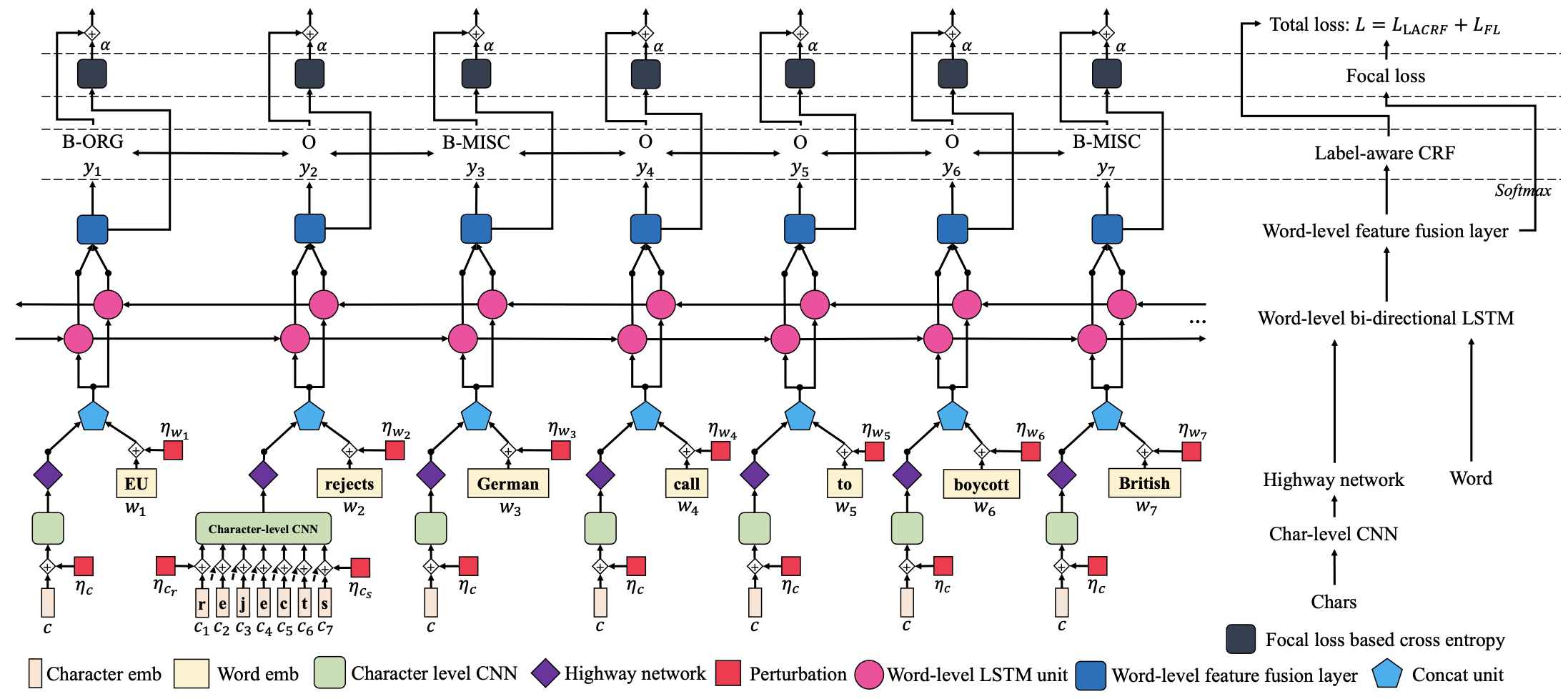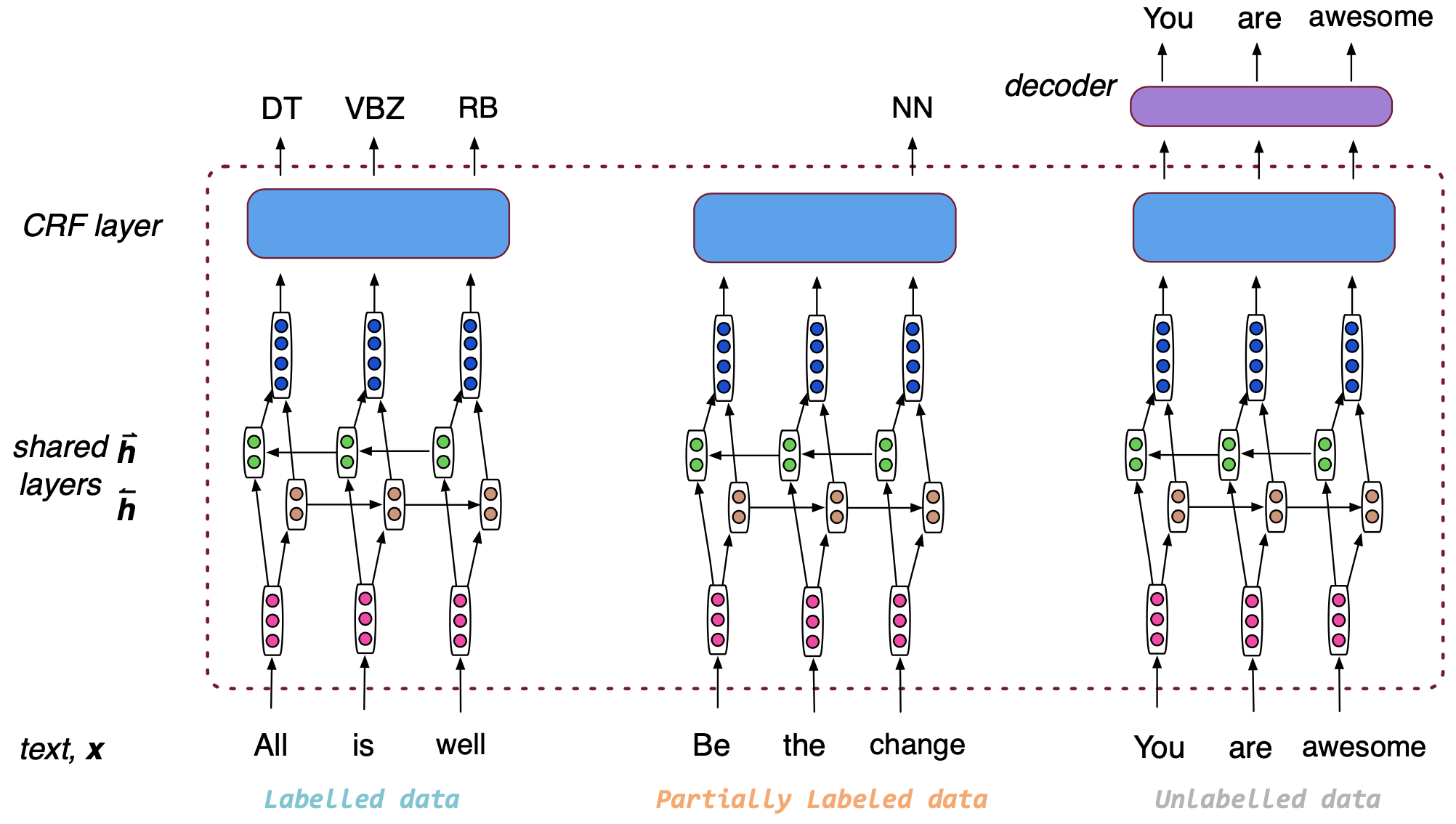This is TensorFlow implementation for paper (* indicates equal contributions):
- Joey Tianyi Zhou*, Hao Zhang*, Di Jin, Xi Peng, Yang Xiao and Zhiguo Cao, "RoSeq: Robust Sequence Labeling", IEEE Transactions on Neural Networks and Learning Systems (IEEE TNNLS), 2019.
- Joey Tianyi Zhou, Meng Fang, Hao Zhang, Chen Gong, Xi Peng, Zhiguo Cao and Rick Siow Mong Goh, "Learning With Annotation of Various Degrees", IEEE Transactions on Neural Networks and Learning Systems (IEEE TNNLS), 2019.
RoSeq: Robust Sequence Labeling Architecture
Learning With Annotation of Various Degrees Architecture
- python 3.x with package tensorflow (
>=1.8.0), ujson, emoji, matplotlib, tqdm, numpy
To train a baseline model, run:
$ python3 run_base.py --task conll2003_ner --raw_path <dataset_path> --save_path <save path> \
--wordvec_path <pre-trained word vectors path>To train a LAVD model, run:
$ python3 run_lavd.py --task conll2003_ner --partial_rate 0.5 --raw_path <dataset_path> \
--wordvec_path <pre-trained word vectors path> --save_path <save path> LAVD use 200d GloVe word embeddings, which are available here.
To train a RoSeq model, run:
python3 run_roseq.py --language spanish --at true --word_project true --focal_loss trueRoSeq used 100d GloVe word embeddings for English (here), while 50d word2vec word embeddings for other languages, which are available here.
Note: to obtain the main results of Table 3 in "RoSeq: Robust Sequence Labeling", you can download
- The trained weights from Box Drive (ckpt) and save them
to
./ckpt/folder. - The processed dataset from Box Drive (data) and save them
to
./datasets/data/folder.
Then run the following commands.
For Spanish (CoNLL-2002 Spanish NER):
python3 train_roseq.py --language spanish --at true --word_project true --concat_rnn false \
--train falseFor Dutch (CoNLL-2002 Dutch NER):
python3 train_roseq.py --language dutch --at true --word_project true --concat_rnn false \
--train falseFor English (CoNLL-2003 English NER):
python3 train_roseq.py --language english --at true --word_project true --concat_rnn false \
--word_dim 200 --train falseFor WNUT-2016 (WNUT-2016 Twitter NER):
python3 train_roseq.py --language wnut2016 --use_orthographic true --at true \
--concat_rnn true --focal_loss true --word_project true --train falseFor WNUT-2017 (WNUT-2017 Twitter NER):
python3 train_roseq.py --language wnut2017 --at true --use_orthographic true --focal_loss true \
--word_project false --concat_rnn true --train falseIf you feel this project helpful to your research, please cite our work.
@ARTICLE{8709849,
author={J. T. {Zhou} and H. {Zhang} and D. {Jin} and X. {Peng} and Y. {Xiao} and Z. {Cao}},
journal={IEEE Transactions on Neural Networks and Learning Systems},
title={RoSeq: Robust Sequence Labeling},
year={2019},
pages={1-11},
doi={10.1109/TNNLS.2019.2911236},
ISSN={2162-2388}
}
and
@article{8611308,
author={J. T. {Zhou} and M. {Fang} and H. {Zhang} and C. {Gong} and X. {Peng} and Z. {Cao} and R. S. M. {Goh}},
journal={IEEE Transactions on Neural Networks and Learning Systems},
title={Learning With Annotation of Various Degrees},
year={2019},
volume={30},
number={9},
pages={2794-2804},
doi={10.1109/TNNLS.2018.2885854},
ISSN={2162-2388},
month={Sep.}
}

